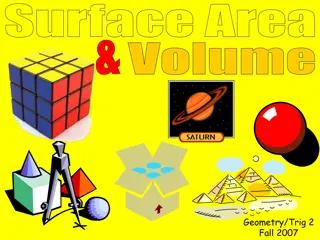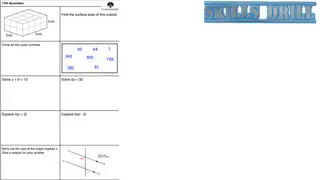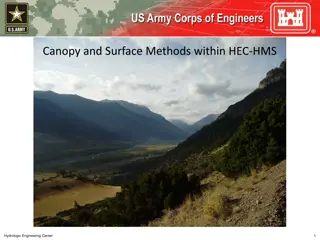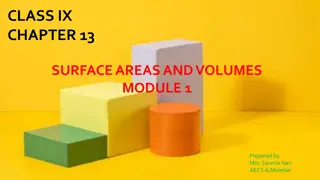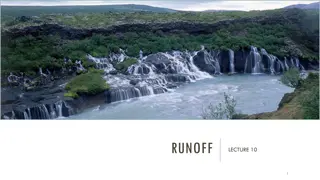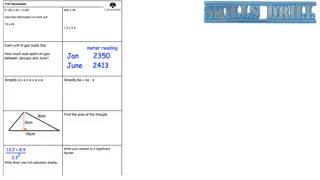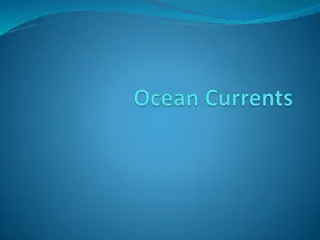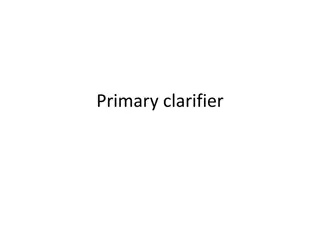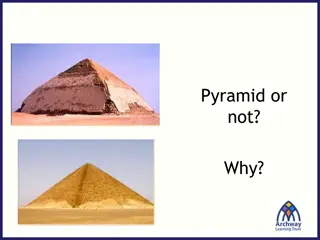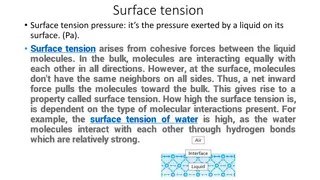Exploring Surface Area in Mathematics
Delve into the concept of surface area as an essential mathematical topic, understanding its significance in everyday life and its application in various 3D shapes. Learn how to calculate surface area for different space figures like prisms and pyramids through step-by-step methods. Engage with essential questions, definitions, and visual aids to enhance your comprehension of surface area calculations.
Download Presentation

Please find below an Image/Link to download the presentation.
The content on the website is provided AS IS for your information and personal use only. It may not be sold, licensed, or shared on other websites without obtaining consent from the author. Download presentation by click this link. If you encounter any issues during the download, it is possible that the publisher has removed the file from their server.
E N D
Presentation Transcript
03.01.2018 Agenda Ticket in the door Current Lesson; Surface Area Wrap-up Unit 4 Test has been rescheduled to Monday 03.05.2018 Ticket in the Door Drop everything and Read!
Surface Surface
SURFACE AREA SURFACE AREA Essential Questions Why should you learn about surface area? Is it something that you will ever use in everyday life? If so, who do you know that uses it? Have you ever had to use it outside of math?
Surface Area Surface Area What does it mean to you? Does it have anything to do with what is in the inside of the prism.? Surface area is found by finding the area of all the sides and then adding those answers up. How will the answer be labeled? Units2 because it is area!
Define Surface Area: The amount of material it would take to cover a 3D shape. The area of everything on the outside of a space figure measured in square units
Types of space figures: Prism a space figure with two parallel sides that are congruent Pyramid a space figure with only one base; its faces are triangles a space figure with a curved surface and two congruent parallel bases that are circles Cylinder Cone a space figure with one circular base and a curved surface that comes to a point a space figure with no bases and only curved surfaces Sphere
Surface Area of a Prism/Pyramid Sum of the area of its faces Steps: 1.Draw and label all of the faces 2.Find the area of each face 3.Add all of the faces together
Find the surface area of the following prism: 8 2 of them 8 cm 2 of them 5 7 6 A = (b)(h) = (5)(8) = 40 (2) = 80 cm2 A = (b)(h) = (6)(7) = 21(2) = 42 cm2 5 cm 7 cm 6 cm A = (b)(h) = (5)(6) = 30 cm2 5 6 Total Area = 42 + 80 + 30 = 152 cm2
Find the surface area of the following Square Pyramid: 10 4 of them 12 cm 12 10 10 cm 10 A = (b)(h) = (10)(10) = 100 cm2 A = (b)(h) = (10)(12) = 60(4) = 240 cm2 Total Area = 240 + 100 = 340 cm2
Surface Area of a Cylinder 2 rh SA = + 2 r Steps: 1.Identify the radius and height 2.Add r and h into equation
Find the surface area of the following prism: = 4 r = 8/2 h = 14 8cm 14cm = = + 14 ) 2 2 2 SA SA rh ( 4 r + 2) 4 ( = 452 + 351 16 . 68 . cm 100 48 . SA SA= 2
Surface Area of a Cone rs SA = + 2r Steps: 1.Identify the radius and slant height 2.Add r and s into equation
Find the surface area of the following prism: = 2 r = 4/2 s = 2.6m 2.6 m 4 m = + 2r SA rs = = ) 6 . 2 ( 2 328 . 16 + 2) 2 ( 56 . 12 SA SA + SA= 2 29m
Surface Area of a Sphere 4 r SA = 2 Steps: 1.Identify the radius 2.Add r into equation
Find the surface area of the following prism: r = 9/2 = 4.5 9 in = 4 r 2 SA = 2) 5 . 4 ( 4 SA SA= 2 254in
Rectangular Prism B How many faces are on here? 6 Find the area of each of the faces. C 5 in A 6 4 Do any of the faces have the same area? If so, which ones? A = 5 x 4 = 20 x 2 =40 B = 6 x 5 = 30 x 2 = 60 C = 4 x 6 = 24 x 2 = 48 Opposite faces are the same. 148 in2 Find the SA
Cube Cube Are all the faces the same? YES A How many faces are there? 4m 6 Find the Surface area of one of the faces. 4 x 4 = 16 Take that times the number of faces. X 6 96 m2 SA for a cube.
Triangular Prism How many faces are there? 5 How many of each shape does it take to make this prism? 2 triangles and 3 rectangles = SA of a triangular prism Find the surface area. Start by finding the area of the triangle. How many triangles were there? 2 Find the area of the 3 rectangles. 4 5 10 m 3 x 2= 12 4 x 3/2 = 6 5 x 10 = 50 = front 4 x 10 = 40 = back 3 x 10 = 30 = bottom SA = 132 m2 What is the final SA?
Triangular Prisms Use the same triangular prism we used before. Let s us the formula this time. 2B + LSA=SA Find the area of the base, which is a triangle because it is a triangular prism. You will need two of them. Now, find the perimeter of that same base and multiply it by how many layer of triangles are in the picture. That is the LSA. Add that to the two bases. Now you should have the same answer as before. Either way is the correct way.
Cylinders Cylinders What does it take to make this? 6 10m 2 circles and 1 rectangle= a cylinder 2B + LSA = SA 2 B 3.14 x 9 = 28.26 X 2 = 56.52 + LSA(p x H) 3.14 x 6 =18.84 x 10 = 188.4 SA = 244.92
Reference https://bj041.k12.sd.us/power%20points/sur face%20area.ppt www.ecusd7.org/ehs/ehsstaff/jlunte/.../5.6% 20surface%20area%20powerpoint.ppt





